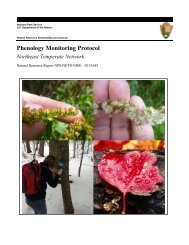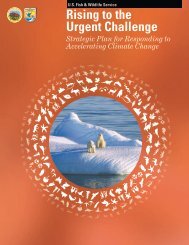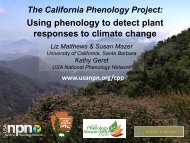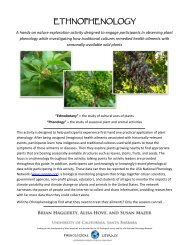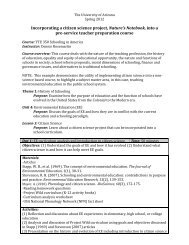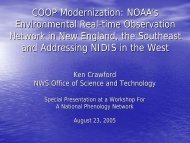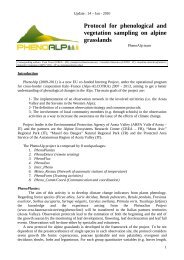The Phenology Handbook - USA National Phenology Network
The Phenology Handbook - USA National Phenology Network
The Phenology Handbook - USA National Phenology Network
Create successful ePaper yourself
Turn your PDF publications into a flip-book with our unique Google optimized e-Paper software.
PHENOLOGY AND CLIMATE CHANGE<br />
A (VERY) BRIEF OVERVIEW OF CLIMATE CHANGE<br />
It is widely known that the Earth’s climate system is changing rapidly. Although there is a range of opinions on<br />
how best to mitigate the consequences of climate change, there is strong agreement on how and why it is occurring.<br />
Here are just a few facts about changes in temperature, documented in the 2007 Assessment Report of<br />
the Intergovernmental Panel on Climate Change (IPCC - http://www.ipcc.ch/):<br />
• Global average surface temperatures have increased by 0.74˚C (1.33˚F) during the last 100 years;<br />
this is the largest and fastest warming trend in the last millennium.<br />
• <strong>The</strong> rate of warming has increased in recent decades. <strong>The</strong> most recent 50 years have warmed at<br />
nearly twice the rate seen in the previous 50 years, and 11 of the last 12 years have been the hottest<br />
in recorded history (since 1850).<br />
• Land surfaces have warmed slightly faster than ocean surfaces, and the greatest rates of surface<br />
warming are continually found in mid- to high-latitude continental regions of the Northern Hemisphere.<br />
<strong>The</strong>se changes, and many others that are not described here, are largely attributable to the emission of greenhouse<br />
gasses into the atmosphere and their continued accumulation, including carbon dioxide (CO 2 ), methane<br />
(CH 4 ), nitrous oxide (N 2 O), and fluorinated gasses (e.g., hydrofluorocarbons, perfluorocarbons, and sulfur<br />
hexafluoride). <strong>The</strong>re is no doubt in the scientific community that human activities such as industrialization,<br />
burning of fossil fuels, and deforestation have contributed to increased concentrations of greenhouse gasses and<br />
therefore to global climate change.<br />
<strong>The</strong>re are multiple ways to define the growing season of a region, but most definitions point to the time<br />
of year that is favorable to plant growth. This metric can change depending on how cold-hardy the plants<br />
in a given habitat are, but a common definition is the time period between the beginning of spring and the<br />
occurrence of the first killing frosts of autumn, otherwise known as the frost-free season. <strong>The</strong> examples<br />
above show the effects of climate change on the physical world (e.g., snowpack, duration of lack and river<br />
ice, and the area of the arctic ice sheet), but climate change has similarly strong influences on the biological<br />
world. One major difference is that, while highly complex mathematical models have been quite successful<br />
in predicting the effects of climate change on physical global activities (such as ice melt), the effects on the<br />
biological world are immeasurably difficult to model and, as a result, are highly unpredictable.<br />
16<br />
CLIMATE CHANGE ON A SEASONAL TIME SCALE – THE CHANGING GROWING SEASON<br />
In order to discuss the connections between climate change and phenology, we first need to understand how<br />
climate change is affecting the timing and intensity of the seasons. <strong>The</strong> term “global warming” often evokes images<br />
of unbearably hot summers. While it is true that summertime high temperatures are rising worldwide, it<br />
often surprises people to learn that in seasonal environments around the world – those characterized by cool or<br />
cold winters and warm or hot summers – winter is the most rapidly warming season. In fact, by many measures<br />
winters are warming at nearly twice the rate of summers. Where this occurs, winters are not only warmer, they<br />
are also shorter, and this change can be seen in several ways:<br />
• <strong>The</strong> amount of time that lakes, rivers, and polar oceans are covered with ice during the winter<br />
is decreasing. In the Northern Hemisphere, observations of early-winter freezing dates for rivers<br />
and lakes over the last 150 years have revealed that freezing is becoming delayed at a rate of<br />
nearly 6 days per century. Ice “breakup” at the end of winter, in turn, is taking place earlier, at a<br />
rate of ~6.5 days per 100 years.



